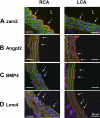Discovery of novel mechanosensitive genes in vivo using mouse carotid artery endothelium exposed to disturbed flow
- PMID: 20551377
- PMCID: PMC2974596
- DOI: 10.1182/blood-2010-04-278192
Discovery of novel mechanosensitive genes in vivo using mouse carotid artery endothelium exposed to disturbed flow
Abstract
Recently, we showed that disturbed flow caused by a partial ligation of mouse carotid artery rapidly induces atherosclerosis. Here, we identified mechanosensitive genes in vivo through a genome-wide microarray study using mouse endothelial RNAs isolated from the flow-disturbed left and the undisturbed right common carotid artery. We found 62 and 523 genes that changed significantly by 12 hours and 48 hours after ligation, respectively. The results were validated by quantitative polymerase chain reaction for 44 of 46 tested genes. This array study discovered numerous novel mechanosensitive genes, including Lmo4, klk10, and dhh, while confirming well-known ones, such as Klf2, eNOS, and BMP4. Four genes were further validated for protein, including LMO4, which showed higher expression in mouse aortic arch and in human coronary endothelium in an asymmetric pattern. Comparison of in vivo, ex vivo, and in vitro endothelial gene expression profiles indicates that numerous in vivo mechanosensitive genes appear to be lost or dysregulated during culture. Gene ontology analyses show that disturbed flow regulates genes involved in cell proliferation and morphology by 12 hours, followed by inflammatory and immune responses by 48 hours. Determining the functional importance of these novel mechanosensitive genes may provide important insights into understanding vascular biology and atherosclerosis.
Figures




Comment in
-
Shear stress: devil's in the details.Blood. 2010 Oct 14;116(15):2625-6. doi: 10.1182/blood-2010-07-293472. Blood. 2010. PMID: 20947689
References
-
- Ross R. Atherosclerosis: an inflammatory disease. N Engl J Med. 1999;340(2):115–126. - PubMed
-
- Libby P. Inflammation in atherosclerosis. Nature. 2002;420(6917):868–874. - PubMed
-
- Ku DN, Giddens DP, Zarins CK, Glagov S. Pulsatile flow and atherosclerosis in the human carotid bifurcation: positive correlation between plaque location and low oscillating shear stress. Arteriosclerosis. 1985;5(3):293–302. - PubMed
-
- VanderLaan PA, Reardon CA, Getz GS. Site specificity of atherosclerosis: site-selective responses to atherosclerotic modulators. Arterioscler Thromb Vasc Biol. 2004;24(1):12–22. - PubMed
-
- Berk BC. Atheroprotective signaling mechanisms activated by steady laminar flow in endothelial cells. Circulation. 2008;117(8):1082–1089. - PubMed
Publication types
MeSH terms
Grants and funding
LinkOut - more resources
Full Text Sources
Other Literature Sources
Medical
Molecular Biology Databases

